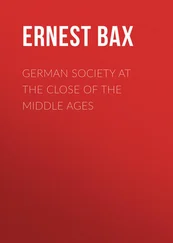Valakhehs was succeeded on the Persian throne by Kavad, the son of Perozes. Kavad was in some ways the ablest of all the Sassanid sovrans. His great achievement was to restore the royal power, which had been gradually declining since the end of the fourth century, and was now well on its way towards the destiny which two hundred years later was to overtake the Merovingian kings of France. The kings had failed to retain their own authority over the Magian priesthood and the official or bureaucratic nobility, and the state was really managed by the principal minister whose title was wazurg-framadhar , and whose functions may be compared to those of a Praetorian Prefect. 35It was one of these ministers to whom Kavad owed his elevation.
Kavad might not have found it easy to emancipate the throne from the tutelage to which it had so long submitted, if there hadn’t been a remarkable popular movement at the time of which he boldly took advantage. 36A communist had arisen in the person of Mazdak, and was preaching successfully among the lower classes throughout Persia the doctrines that all men are equal, that the present state of society is contrary to nature, and that the acts condemned by society as crimes are, as merely tending to overthrow an unjustifiable institution, blameless. Community of property and wives was another deduction. Kavad embraced and actually helped to promulgate these anarchical doctrines. His conversion to Mazdakism was not, of course, sincere; his policy was to use the movement as a counterpoise to the power of the nobles and the Zoroastrian priests. There was a struggle for some years of which we do not know the details, but at length the nobles managed to immure the dangerous king in the Castle of “Lethe” (A.D. 497). 37Mazdak was imprisoned, but forcibly released by his disciples. After a confinement of two or three years Kavad found means to escape, and with the help of the Ephthalites was reinstated on the throne (A.D. 499).
During his reign Kavad began a number of reforms in the organisation of the state which tended to establish and secure the royal authority. He did not do away with the high office of wazurg-framadhar , but he deprived it of its functions and it became little more than a honorific title. 38He began a new survey of the land, for the purpose of instituting a system of sound finance. 39Towards the end of his reign his position was so strong that he was able to take measures to suppress the anti-social Mazdakite sect, which he had suffered only because the hostility between these enthusiasts and the nobles and priests helped him to secure and consolidate the royal power.
§ 2. The Persian War of Anastasius (A.D. 502-507)
It was some time after the restoration of Kavad that hostilities broke out, after sixty years of peace between Persia and the Empire. In their financial embarrassments the Sassanid kings were accustomed to apply to Constantinople, and to receive payments which were nominally the bargained contribution to the defence of the Caucasian passes. The Emperors Leo and Zeno had extricated Perozes from difficulties by such payments. 40But in A.D. 483 the Persians repudiated a treaty obligation. It had been agreed by the treaty of Jovian that Persia was to retain Nisibis for 120 years and then restore it to the Romans. This period now terminated and the Persians declined to surrender a fortress which was essential to their position in Mesopotamia. The Emperor Zeno did not go to war, but he refused to make any further payments for the defence of the Caucasus. When king Valakhesh applied to him he said: “You have the taxes of Nisibis, which are due rightfully to us.” 41The Imperial Government cannot have seriously expected Persia to fulfil her obligation in regard to Nisibis, but her refusal to do so gave the Romans the legal right to decline to carry out their contract to supply money. Anastasius followed the policy of Zeno when Kavad renewed the demand with menaces in A.D. 491. 42
After his restoration Kavad was in great straits for money. He owed the Ephthalites a large sum which he had undertaken to pay them for their services in restoring him to the throne, and he applied to Anastasius. The Emperor had no intention of helping him, as it appeared to be manifestly to the interest of the Empire to promote hostility and not friendship between the Ephthalites and the Persians. It is said that his refusal took the form of a demand for a written acknowledgment ( cautio ), as he knew that Kavad, unfamiliar with the usages of Roman law, would regard such a mercantile transaction as undignified and intolerable. 43Kavad resolved on war, and the Hundred Years’ Peace was broken, not for the first time, after a duration of eighty years (August, A.D. 502). 44
The Persian monarch began operations with an invasion of Armenia, and Theodosiopolis fell into his hands by treachery. Then he marched southwards, attacked Martyropolis which surrendered, and laid siege to Amida. This city, after a long and laborious winter siege beginning in October, was surprised in January (A.D. 503), chiefly through the negligence of some monks who had undertaken to guard one of the towers, and having drunk too much wine slumbered instead of watching. 45There was a hideous massacre which was stayed by the persuasions of a priest, the survivors were led away captive, and Amida was left with a garrison of 3000 men. 46
On the first news of the invasion the Emperor had sent Rufinus as an ambassador to offer money and propose terms of peace. 47Kavad detained him till Amida fell, and then despatched him to Constantinople with the news. Anastasius made military preparations, but the forces which he sent were perhaps not more than 15,000 men. 48And, influenced by the traditions of the Isaurian campaigns, he committed the error of dividing the command, in the same theatre of war, among three generals. These were the Master of Soldiers in the East, Areobindus, the great-grandson of Aspar (on the mother’s side) and son-in-law of the Emperor Olybrius; and the two Masters of Soldiers in praesenti , Patricius, and the Emperor’s nephew Hypatius, whose military inexperience did not deserve such a responsible post. 49
The campaign opened (May, A.D. 503) with a success for Areobindus, in the neighbourhood of Nisibis, but the enemy soon mustered superior forces and compelled him to withdraw to Constantia. The jealousy of Hypatius and Patricius, who with 40,000 men had encamped 50against Amida, induced them to keep back the support which they ought to have sent to their colleague. Soon afterwards the Persians fell upon them, their vanguard was cut up, and they fled with the rest of their army across the Euphrates to Samosata (August). 51
Areobindus meanwhile had shut himself up in Edessa, and Kavad determined to attack it. The Christian legend of Edessa was in itself a certain challenge to the Persian kings. It was related that Abgar, prince of Edessa and friend of the Emperor Augustus, suffered in his old age from severe attacks of gout. Hearing of the miraculous cures which Jesus Christ was performing in Palestine, Abgar wrote to him, inviting him to leave a land of unbelievers and spend the rest of his life at Edessa. Jesus declined, but promised the prince recovery from his disease. The divine letter existed, and the Edessenes afterwards discovered a postscript, containing a pledge that their city would never be taken by an enemy. The text of the precious document was inscribed on one of the gates, as a sort of phylactery, and the inhabitants put implicit confidence in the sacred promise. 52It is said that the Saracen sheikh Naman urged on Kavad against Edessa, and threatened to do there worse things than had been done at Amida. Thereupon a wound which he had received in his head swelled, and he lingered in pain for two days and died. 53But notwithstanding this sign Kavad persisted in his evil intention.
Читать дальше












